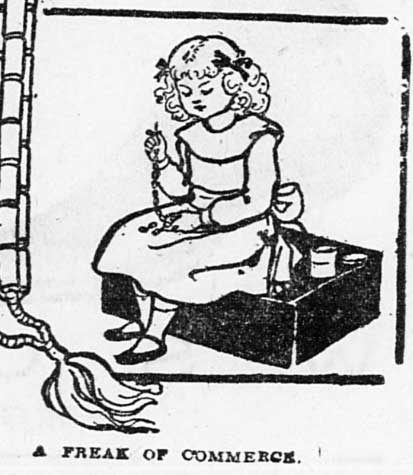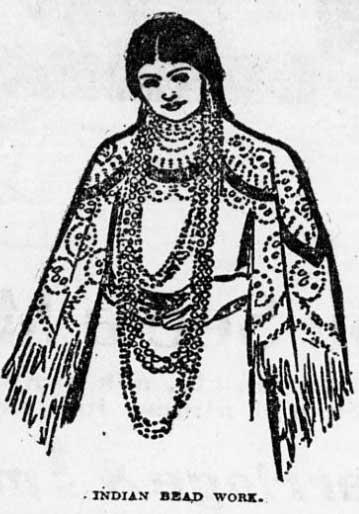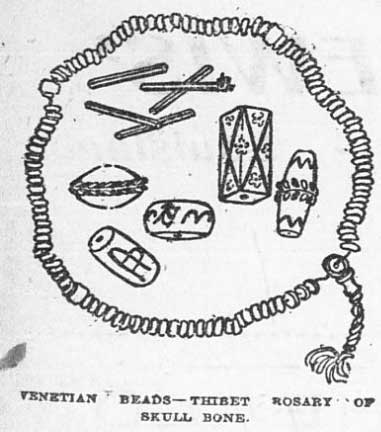
You have probably heard that beads were once used as a form of money or for barter and trade. How prevalent was this custom? Who were the people who prized beads so much that they would trade just about anything for a new batch of beads?
This article, found in The Rice Belt Journal in 1902, gives an interesting account on the history of beads used in commerce.

BEADS OF COMMERCE
Run your fingers down the string of beads which a little girl brings home from kindergarten and you may come across a cylindrical bead, long and thick, with an odd, murky, creamy tint to it.
It is for all the world like a half-inch of clay pipe stem, and is nothing less than one of the beads manufactured for the African slave trade when that traffic was at its height. Such are the wry twists which Father Time gives to the commerce of nations that today it is finding its way into school houses to beguile the hands of tiny Americans.
These beads formed no small factor in the trade in “black ivory,” and Boston and New York ships used to set out for the Slave Coast laden with 50 cases or more of the curious baubles, an industry which was kept up secretly until nearly the time of the civil war. Stanley found the beads far in the interior of Africa, where they passed as the universal currency under the name of Sofi, and where they still doubtless circulate largely.

When the slave traders were finally put out of business a New York firm found itself with a quantity of the beads on hand which were of no possible use in any other line of business. So, at least, it was thought then. They were stowed away in boxes for a generation and became part of the stock of the best known of New York’s bead importers.
In ransacking the establishment one day for odd beads to include in kindergarten supplies these were run across by a member of the firm, and since then the old time purchase money of American slavery had been doled out regularly as a rainy day article for children.
The bead business is an interesting one and filled with such contrarieties. For fashions in beads change as fashions in everything else, and the trade shifts to meet the demand.
Birmingham is the seat of the English industry, but the importation to the United States — there is practically no home manufacture — is largely from Italy, France, and Bohemia. The value of the imports in this line in 1901 was $814,894.60, netting duties amounting to $478,669.25.

Just at present two distinctive uses to which beads are put are Cyrano chains and the dainty crocheted bags which have come into style in the last four years.
Both are revivals and of the bags some rare heirlooms have been brought out, purses such as our great grandmothers carried. Some of these purses are mounted on solid gold backs, the metal alone in which is worth $200, and with beads worked in in the most exquisite patterns.
Beads are now used for the bearings on patent fishing tackle, spoon hooks and the like — a reminder of the fate of the cowry shell, which is another curious bead link in the history of civilization. From prehistoric times it was used in necklaces and chains, as charms and as money throughout the islands of the Pacific and Indian oceans. Today it has a market in America among dealers in aquarium supplies and as decorations for fancy boxes, while in England its bright color has given it value as bait for cuttle fish.
Wood, glass, porcelain, jewels of all sorts, steel, copper, silver — these are some of the materials out of which beads are fashioned. Some are mounted, some cut and some blown. Beads of fourteen karat gold makes up the tracery of the most costly purses, and copper beads, heavily gilded, pass as an imitation.
Amethysts, garnets and other cut stones are reproduced to a nicety and the manufacture of imitation pearls forms an important part of the industry. The more costly receive seven coats of pigment and weight and solidity are given by filling the interior of the blown glass with wax. Strings of such beads sell for $20 and more, and it would be a wise oyster that could pick out his own pearl among them.
There is a trade story of some forgotten genius, who invented a process of making pearl beads of rice. He went to sleep, big with dreams of riches, only to find an awakening that his jewels had been eaten up by mice.
When it comes to the source of the bead supply there are more contrarieties than ever. Imitation pearls and metal beads come largely from France, and yet beads from Bohemia, Egyptian and Turkish beads as they are called — the quaint necklace beads which smack of the far East — are made in Venice; and the long colored beads brought back in draperies from Japan were originally transparent and turned out in Europe. The Japanese merely give them a porcelain lining.
Real coral comes, most of it, from Italy, its imitations from Italy, Bohemia and France. Many of the cheaper colored beads are made in Bohemia, and the finer work is the Venetian output.
While the United States is still importing beads, a glass factory at Jamestown used for their manufacture was one of the first industries started in America. That is another contrariety. The factory was, however, for the making of beads for the Indian trade and had to compete with still earlier beads of the redskins themselves — wampum.
From its use as an ornament wampum had become the currency of the redskins and a source of trade to tribes along the seaboard, says the New York Sun. A factory for making wampum for the Indian trade survived at Park Ridge, N.J., until about 1875. [Source]

